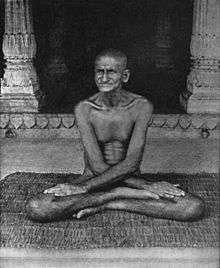Swami Bhaskarananda Saraswati
Swami Bhaskarananda Saraswati (1833–1899) was a noted 19th-century sannyasin and saint of Varanasi, India.[1] He wandered over India for thirteen years before settling in Anandabag near the Durga Mandir, in 1868. A Sanskrit and Vedic scholar turned ascetic of Dashanami Dandi sannyasi order, many kings visited him to seek advise, and he also reported be an advisor counsel to Kashi Naresh (Maharaja of Kingdom of Kashi), today his samadhi shrine is situated at Durga Kunda, adjacent to the historic Durga Mandir in Varanasi.[2]
Swami Bhaskarananda Saraswati | |
|---|---|
 | |
| Personal | |
| Born | 1833 |
| Died | 1899 Varanasi |
| Religion | Hinduism |
Biography
Swamiji's pre-monastic name was Matiram Misra. Born into a Brahmin family in Kanpur district, Uttar Pradesh,[3] was invested with the sacred thread at the age of eight and was married at the age of twelve. From age eight to seventeen, he was a diligent and most successful student of Sanskrit. A son was born to him at the age of eighteen. By this event he was, in his own opinion, freed from any further social obligations. So one day he disappeared from his father's house and went on foot to Ujjain, where he put up a temple of Siva. He continued his Vedantic studies and also started practicing yoga. He then traveled to all the parts of India and devoted to study Vedanta philosophy[4] from noted masters including Pandit Anant Ram of Patna, who was at Haridwar at the time. At about age 27, he was initiated into the holy order of Sannyas by Paramahamsa Swami Purnananda Saraswati of Ujjain, and christened Swami Bhaskarananda Saraswati, a name by which he was known afterwards.[3]
For thirty-five years Swami traveled around India, always practicing tapas. From his long ineffable knowledge he had desired, he settled down for the remainder of his life in the sacred city of Varanasi and miracles of healing were attributed to him.[4]
Today, his samadhi shrine situated at Durga Kunda, adjacent to the historic Durga Mandir in Varanasi is maintained by a small trust.[2]
His followers
Alexandra David-Néel, she studied yoga with the great Swami Bhaskarananda (of Varanasi), who lived the whole year in a rose garden.[5] He too was reputed to have yogic powers, and had foreseen his own death. Though his influence spanned all sections of society, the transformation of character of several notorious pandas wrought by his influence is especially worth mentioning.[6] Jang Bahadur as known as Maharaja Jung Bahadur Rana, the King of Nepal and founder of the Rana dynasty of Nepal, has written a pamphlet about Swami.[7] Ernest Binfield Havell (1864–1937), a close friend of Indologist Sir John Woodroffe was also devoted to him.[8]PAWAN BHASKAR PANDEY MAITHA KANPUR 9794565800
In popular culture
He also finds mention in Mark Twain's non-fiction travelogue Following the Equator (1897), who met Swami in Varanasi.[9][10] Apart from that American explorer couple, Fanny Bullock Workman and William Hunter Workman also met him at the Ananda Bagh garden.[11]
References
- Akshay Kumar Banerjee (1967). Discourses on Hindu spiritual culture, (Volume 3). S. Chand. p. 42.
- Bradley R. Hertel; Cynthia Ann Humes (1993). Living Banaras: Hindu religion in cultural context. SUNY Press. p. 172. ISBN 0-7914-1331-4.
- Theosophical Society (Madras, India) (1899). The Theosophist. Theosophical Pub. House. 20: 697. Missing or empty
|title=(help) - John Campbell Oman (2003). Mystics, Ascetics and Saints of India. Kessinger Publishing. p. 208. ISBN 0-7661-4756-8.
- "A Mystic in Tibet – Alexandra David-Neel". mysteriouspeople.com.
- "The Holy City of Vishwanatha". hindupedia.com.
- Mark Twain (2006). Mark Twain's Adventures of Tom Sawyer. Shoes & Ships & Sealing Wax. p. 780. ISBN 0-9548401-8-6.
- Kathleen Taylor (2001). Sir John Woodroffe, Tantra and Bengal: 'an Indian soul in a European body?'. Routledge. p. 96. ISBN 0-7007-1345-X.
- Following the Equator – Chapter 53 (Text) Archived 17 December 2010 at the Wayback Machine. literaturecollection.com
- Raj Kumar Gupta (1986). The Great Encounter: A study of Indo-American literature and cultural relations. Abhinav Publications. p. 125. ISBN 81-7017-211-X.
- William Hunter Workman; Fanny Bullock Workman (1904). Through town and jungle: fourteen thousand miles a-wheel among the temples and people or the Indian plain. T. F. Unwin.
Further reading
- Gopal Chunder Chatterjee (1893). Yatindra Charitam or short life of Swami Bhaskarananda Saraswati of Benares.
- Swayam Prakashanand Maithila (1902). List of foreign visitors to Shree Swami Bhaskaranand Saraswati at Benares: With a portrait and brief sketch of his sacred life. Bharat-jiwau Press.
- W. M. Zumbro, Religious Penances and Punishments Self-inflicted by the Holy Men of India in National Geographic, December 1913, page 1309.
- Swami Varishthananda, Varanasi: The City of Saints, Sages, and Savants in Prabuddha Bharata, November 2007, page 633.
External links
- The Holy Man of Benares – Swami Bhaskarananda Saraswathi (LOC) by William Henry Jackson, 1843–1942 photographer
- Swami Bhaskarananda at Hindupedia.
